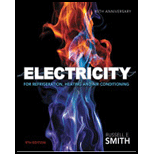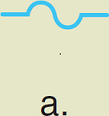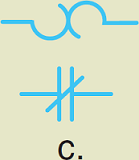
Electricity for Refrigeration, Heating, and Air Conditioning
9th Edition
ISBN: 9781285179988
Author: Russell E. Smith
Publisher: Cengage Learning
expand_more
expand_more
format_list_bulleted
Concept explainers
Textbook Question
Chapter 5, Problem 13RQ
Identify the following symbols for switches:





Expert Solution & Answer
Trending nowThis is a popular solution!

Students have asked these similar questions
20-4-2025
Exam-2-Tribology
Q1: What are the assumptions of hydrodynamic lubrication theory:
Q2: Explain with sketch the cycle or process of engine lubrication system-pressurized
lubrication system
Q3: A short bearing is designed to operate with an eccentricity ratio = 0. 7. The journal
diameter is 60 mm, and its speed is 1300 r.p.m. The journal is supported by a short
hydrodynamic bearing of length L/D = 0. 5, and clearance ratio C/R = 103. The radial load
on the bearing is 9800 N.
a. Find the Sommerfeld number.
b. Find the minimum viscosity of the lubricant for operating at ε = 0.7
c. Select a lubricant if the average bearing operating temperature is 70°c
Q4: Two parallel circular disks of 100 mm diameter have a clearance of Imm between them.
Under load, the downward velocity of the upper disk is 2 m/s. At the same time, the lower disk
is stationary. The clearance is full of SAE 40 oil at a temperature of 60°c.
a. Find the load on the upper disk that results in the instantaneous…
Tribobolgy
15/2022
Monthly Exam.
Automobile Eng. Dert
2nd Semster/3rd class
Max. Mark: 100%
7. Viscosity of multi-grade oils
(a) Reduces with temperature
(c) is less sensitive to temperature
(b) Increases with temperature
(d) None of the above
8. In a hydrodynamic journal bearing if eccentricity ratio = 1, it means
(a) Journal/shaft is subjected to no load and the rotational speed is very high.
(b) Journal is subjected to no load and the rotational speed is moderate
(c) Journal is subjected to very light load and the rotational speed is very high.
(d) Journal is subjected to very high load and the rotational speed is negligible.
Q4/ The journal speed of a 100mm diameter journal is 2500 rpm. The journal is supported by
a short hydrodynamic bearing of length L=0.6D, eccentricity ratio = 0.75 and a clearance
ratio C/R=0.001. The radial load on the bearing is 10 kN. The lubricant is SAE 30, and the
operating temperature of the lubricant in the bearing is 700C.
1- Assume…
1 of 2
Monthly Exam.
Automobile Eng. Dert
2nd Semster/3rd class
Max. Mark: 100%
Q1/A/ Compare between the long and short journal bearings
B/ With the help of Stribeck's curve, discuss different regimes of lubrication.
C/ Explain the importance of Tribology in the design of different machine elements
Q2 /A/ According to the SAE viscosity grading system all engine oils are divided into two
classes: monograde and multi-grade. Compare between them?
B/What are the differences between grease and Synthetic oils
C/ Explain the effect of eccentricity ratio & with respect to hydrodynamic journal bearing.
Q3/A/ What are the major factors which affect the selection of lubricants?
B/What are the criteria to classify sliding bearings?
C/ Answer of the following:
1. According to the SAE viscosity classification, the oil (SAE 40) is lower viscosity than the
oil (SAE 20) at the same temperature. (True or False)
2. For a slow speed-highly loaded bearing, used oils of high viscosity; while for high-speed…
Chapter 5 Solutions
Electricity for Refrigeration, Heating, and Air Conditioning
Ch. 5 - What are the three types of electrical diagrams...Ch. 5 - A load is an electrical device that __________. a....Ch. 5 - What is the major load of an air-conditioning...Ch. 5 - Identify the following symbols for loads:Ch. 5 - Prob. 5RQCh. 5 - What do the terms normally open and normally...Ch. 5 - What is the difference between a magnetic starter...Ch. 5 - Prob. 8RQCh. 5 - Draw a heating and a cooling thermostat and...Ch. 5 - A three-pole contactor would allow how many paths...
Ch. 5 - A disconnect switch is used to __________. a. open...Ch. 5 - What determines whether a pressure switch opens or...Ch. 5 - Identify the following symbols for...Ch. 5 - What is the difference between a thermal overload...Ch. 5 - What is the purpose of a transformer? Draw the...Ch. 5 - Which of the following is not a requirement for an...Ch. 5 - What is the purpose of a legend on a schematic...Ch. 5 - A factual diagram is _____. a. a pictorial diagram...Ch. 5 - Identify the following symbols for safety devices.Ch. 5 - Prob. 20RQCh. 5 - True or False: The schematic diagram tells service...Ch. 5 - What is the difference between a pilot duty and a...Ch. 5 - What type of switch would be used to open or close...Ch. 5 - What is the purpose of a fuse in an electrical...Ch. 5 - True or False: A solenoid valve is a device that...Ch. 5 - What is a signal light used for in a control...Ch. 5 - Change the following normally open elements from...Ch. 5 - Draw the symbols for the following electrical...Ch. 5 - Add letter designations to the symbols to indicate...Ch. 5 - Draw a symbol for a magnetic starter.
Knowledge Booster
Learn more about
Need a deep-dive on the concept behind this application? Look no further. Learn more about this topic, mechanical-engineering and related others by exploring similar questions and additional content below.Similar questions
- The uniform rods have a mass per unit length of 10kg/m . (Figure 1)If the dashpot has a damping coefficient of c=50N⋅s/m , and the spring has a stiffness of k=600N/m , show that the system is underdamped, and then find the pendulum's period of oscillation.arrow_forward10-50. The principal plane stresses and associated strains in a plane at a point are σ₁ = 30 ksi, σ₂ = -10 ksi, e₁ = 1.14(10-3), €2=-0.655(103). Determine the modulus of elasticity and Poisson's ratio. emps to plum... Wednesday FI a וח 2 Q Search 48 F5 - F6 4+ F7 FB F9 FIO FII F12 & * S 6 7 8 9 ㅁ F2 # *F3 3 $ 4 F4 % W E R T Y ப S ALT D F G H X C V B N J Σ H L ว { P [ ] ALT " DELETE BACKSPACE NUM LOCK T 7 HOME ENTER 4 PAUSE SHIFT CTRL Earrow_forward10−9. The state of strain at the point has components of ϵx = −100(10−6), ϵy = −200(10−6), and γxy=100(10−6). Use the strain transformation equations to determine (a) the in-plane principal strains and (b) the maximum in-plane shear strain and average normal strain. In each case specify the orientation of the element and show how the strains deform the element within the x−y plane.arrow_forward
- The strain gage is placed on the surface of the steel boiler as shown. If it is 0.5 in. long, determine the pressure in the boiler when the gage elongates 0.2(10−3) in. The boiler has a thickness of 0.5 in. and inner diameter of 60 in. Also, determine the maximum x, y in-plane shear strain in the material. Take Est=29(103)ksi, vst=0.3.arrow_forward(read image, answer given)arrow_forward6/86 The connecting rod AB of a certain internal-combustion engine weighs 1.2 lb with mass center at G and has a radius of gyration about G of 1.12 in. The piston and piston pin A together weigh 1.80 lb. The engine is running at a constant speed of 3000 rev/min, so that the angular velocity of the crank is 3000(2)/60 = 100л rad/sec. Neglect the weights of the components and the force exerted by the gas in the cylinder compared with the dynamic forces generated and calculate the magnitude of the force on the piston pin A for the crank angle 0 = 90°. (Suggestion: Use the alternative moment relation, Eq. 6/3, with B as the moment center.) Answer A = 347 lb 3" 1.3" B 1.7" PROBLEM 6/86arrow_forward
- 6/85 In a study of head injury against the instrument panel of a car during sudden or crash stops where lap belts without shoulder straps or airbags are used, the segmented human model shown in the figure is analyzed. The hip joint O is assumed to remain fixed relative to the car, and the torso above the hip is treated as a rigid body of mass m freely pivoted at O. The center of mass of the torso is at G with the initial position of OG taken as vertical. The radius of gyration of the torso about O is ko. If the car is brought to a sudden stop with a constant deceleration a, determine the speed v relative to the car with which the model's head strikes the instrument panel. Substitute the values m = 50 kg, 7 = 450 mm, r = 800 mm, ko = 550 mm, 0 = 45°, and a = 10g and compute v. Answer v = 11.73 m/s PROBLEM 6/85arrow_forwardUsing AutoCADarrow_forward340 lb 340 lb Δarrow_forward
- 4. In a table of vector differential operators, look up the expressions for V x V in a cylindrical coordinate system. (a) Compute the vorticity for the flow in a round tube where the velocity profile is = vo [1-(³] V₂ = Vo (b) Compute the vorticity for an ideal vortex where the velocity is Ve= r where constant. 2πг (c) Compute the vorticity in the vortex flow given by Ve= r 2лг 1- exp ( r² 4vt (d) Sketch all the velocity and vorticity profiles.arrow_forwardIn the figure, Neglects the heat loss and kinetic and potential energy changes, calculate the work produced by the turbine in kJ T = ??? Steam at P=3 MPa, T = 280°C Turbine Rigid tank V = 1000 m³ Turbine Rigid tank V = 100 m³ V = 1000 m³ V = 100 m³ The valve is opened. Initially: evacuated (empty) tank O a. 802.8 Initially: Closed valve O b. 572 O c. 159.93 Od. 415 e. 627.76 equilibriumarrow_forwardPlease find the torsional yield strength, the yield strength, the spring index, and the mean diameter. Use: E = 28.6 Mpsi, G = 11.5 Mpsi, A = 140 kpsi·in, m = 0.190, and relative cost= 1.arrow_forward
arrow_back_ios
SEE MORE QUESTIONS
arrow_forward_ios
Recommended textbooks for you
 Welding: Principles and Applications (MindTap Cou...Mechanical EngineeringISBN:9781305494695Author:Larry JeffusPublisher:Cengage Learning
Welding: Principles and Applications (MindTap Cou...Mechanical EngineeringISBN:9781305494695Author:Larry JeffusPublisher:Cengage Learning Understanding Motor ControlsMechanical EngineeringISBN:9781337798686Author:Stephen L. HermanPublisher:Delmar Cengage Learning
Understanding Motor ControlsMechanical EngineeringISBN:9781337798686Author:Stephen L. HermanPublisher:Delmar Cengage Learning Automotive Technology: A Systems Approach (MindTa...Mechanical EngineeringISBN:9781133612315Author:Jack Erjavec, Rob ThompsonPublisher:Cengage Learning
Automotive Technology: A Systems Approach (MindTa...Mechanical EngineeringISBN:9781133612315Author:Jack Erjavec, Rob ThompsonPublisher:Cengage Learning Refrigeration and Air Conditioning Technology (Mi...Mechanical EngineeringISBN:9781305578296Author:John Tomczyk, Eugene Silberstein, Bill Whitman, Bill JohnsonPublisher:Cengage Learning
Refrigeration and Air Conditioning Technology (Mi...Mechanical EngineeringISBN:9781305578296Author:John Tomczyk, Eugene Silberstein, Bill Whitman, Bill JohnsonPublisher:Cengage Learning Precision Machining Technology (MindTap Course Li...Mechanical EngineeringISBN:9781285444543Author:Peter J. Hoffman, Eric S. Hopewell, Brian JanesPublisher:Cengage Learning
Precision Machining Technology (MindTap Course Li...Mechanical EngineeringISBN:9781285444543Author:Peter J. Hoffman, Eric S. Hopewell, Brian JanesPublisher:Cengage Learning Electrical Transformers and Rotating MachinesMechanical EngineeringISBN:9781305494817Author:Stephen L. HermanPublisher:Cengage Learning
Electrical Transformers and Rotating MachinesMechanical EngineeringISBN:9781305494817Author:Stephen L. HermanPublisher:Cengage Learning

Welding: Principles and Applications (MindTap Cou...
Mechanical Engineering
ISBN:9781305494695
Author:Larry Jeffus
Publisher:Cengage Learning

Understanding Motor Controls
Mechanical Engineering
ISBN:9781337798686
Author:Stephen L. Herman
Publisher:Delmar Cengage Learning

Automotive Technology: A Systems Approach (MindTa...
Mechanical Engineering
ISBN:9781133612315
Author:Jack Erjavec, Rob Thompson
Publisher:Cengage Learning

Refrigeration and Air Conditioning Technology (Mi...
Mechanical Engineering
ISBN:9781305578296
Author:John Tomczyk, Eugene Silberstein, Bill Whitman, Bill Johnson
Publisher:Cengage Learning

Precision Machining Technology (MindTap Course Li...
Mechanical Engineering
ISBN:9781285444543
Author:Peter J. Hoffman, Eric S. Hopewell, Brian Janes
Publisher:Cengage Learning

Electrical Transformers and Rotating Machines
Mechanical Engineering
ISBN:9781305494817
Author:Stephen L. Herman
Publisher:Cengage Learning
Materials Science Mechanical Engineering - Part 3 Corrosion Explained; Author: Mega Mechatronics;https://www.youtube.com/watch?v=Il-abRhrzFY;License: Standard Youtube License